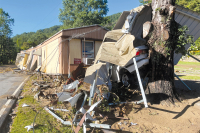More wilderness areas not a good idea
To the Editor:
I want to commend the U.S. Forest Service and district ranger staffs for an excellent job in producing a very thorough analysis of what alternatives should be considered for additional wilderness designation in the Nantahala & Pisgah National Forests new management plan (see story page 50). If you want to read the analysis of each area that was considered for wilderness recommendation go to http://www.fs.usda.gov/Internet/FSE_DOCUMENTS/fseprd511839.pdf. Here you can read the analysis of each of the 54 areas that were considered and why it was recommended or not recommended.
The Forest Service formed a Stakeholders Forum for input and guidance on the new management plan. This Forum has met monthly for almost a year. I am a member of the Forum. The Forum also included members from the Sierra Club, MountainTrue, Southern Environmental Law Center, Wilderness Society, recreational interests, timber interests, Ruffed Grouse Society, Fish & Wildlife Conservation Council, N.C. Wildlife Resources Commission (who provided excellent science and hard data) and numerous others.
All interests had ample opportunity to provide their input and to solicit input from their members. The one group that was not included in the Forum was the counties that have national forest lands within their borders — and 12 of those counties have passed resolutions opposing additional wilderness in their county. The county commissions are our elected representatives and they needed to be heard on an issue this important.
Wilderness advocates have a vision of what the Appalachian forests looked like when Europeans first arrived in North America and they want to go back to that imaginary state. It is essentially a very flawed vision. If you want to read some excellent research of what our mountains looked like then (and had looked like for thousands of years) read chapter 12 of Natural Disturbances and Historic Range of Variation, by Cathryn S. Greenberg (USDA Forest Service, Southern Research Station – Asheville) and Beverly S. Collins (Western Carolina University).
We have lots of wilderness in Western North Carolina in the Pisgah and Nantahala national forests (over 93,000 acres) and in the Great Smoky Mountains National Park (over 500,000 acres). That wilderness is protected by federal statute. What we need is attention to our local economies, restoration of desirable native forest species and management of wildlife habitat. Those are the things that were not managed properly in the current management plan, and we have the opportunity to get back on the right track.
And, no, there will be no vast clear-cuts, there will be no polluted streams, there will not be a vast network of logging roads slashed through the forest. The national forest will look a lot like it looks today with the addition of a mosaic of areas where timber has been cut, trees are regrowing, old growth forest will be very common, wilderness will exist as it does today and the forest will become a healthy mix of trees of all ages AND a healthy abundant mix of wildlife species that prefer all those types of habitat.
Jim Gray
Franklin





